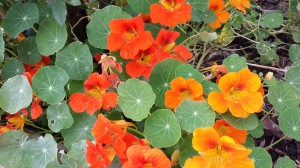By Gael (Plot 234)
Nasturtium (Tropaelum majus) is of the Cruciferae family.
Most of us would know nasturtium with its large bright green umbrella like leaves and glowing red, orange and yellow flowers. It is a hardy climbing and creeping annual growing in most soil conditions and enjoying a sunny well drained position. Usually planted in Spring, its sweet smelling flowers emerge in Summer lasting right through to late Autumn. It’s bright beauty however is not its only quality.
Originating from Peru, it is a valuable asset to our gardens as it exudes a pungent essence which repels many garden pests, this essence is also secreted into the soil and is taken up by nearby plants improving their resistance to pests.
All parts of the plant can be eaten. The leaves have a sharp rocket like pungency and marry well with soft mild cheeses, eggs and are delicious in sandwiches and salads. The flowers are less strongly flavoured and are a beautiful addition to salads. The fat young seeds taste stronger than the leaves and can be used in a variety of ways. They are particularly good in tartare sauce and as a substitute for horseradish. They can be pickled in vinegar and are often known as false capers.
Medicinally, Nasturtium provides an antiseptic and tonic treatment for the blood and digestive system, relieves anxiety and constipation and can help clear skin and eyes.
have the kids plant some nasturtium seeds. They are wonderful for children to plant as they are so easy to grow. The children love seeing the silvery beads of water collect in their leaves.
Reference: “The Complete Book of Herbs and Spices”….Clair Loewenfeld & Philippa Bach.
Wikipedia

